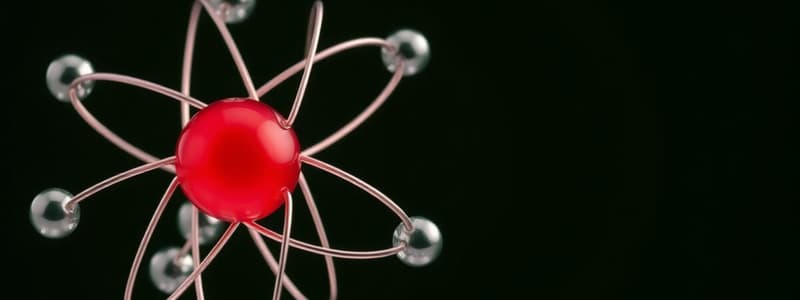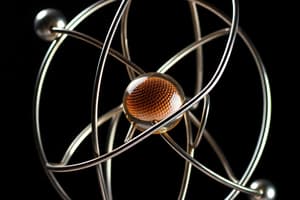Podcast
Questions and Answers
What limitation does Rutherford's model have regarding atomic stability?
What limitation does Rutherford's model have regarding atomic stability?
- It fails to explain the stability of atoms based on classical physics. (correct)
- It explains the energy levels of electrons adequately.
- It incorrectly states that electrons orbit the nucleus in fixed paths.
- It does not account for the radiation emitted by electrons.
According to Bohr’s model, what happens when an electron transitions from a high energy state to a lower energy state?
According to Bohr’s model, what happens when an electron transitions from a high energy state to a lower energy state?
- The electron moves closer to the nucleus without energy change.
- The atom absorbs a quantum of energy.
- The atom emits a quantum of radiation. (correct)
- The atom does not emit any radiation.
What condition must be met for the electron's orbit to be mechanically stable according to Bohr's model?
What condition must be met for the electron's orbit to be mechanically stable according to Bohr's model?
- The angular momentum must be an integral multiple of h/2π. (correct)
- Electrons must radiate energy continuously.
- The electron must be stationary in its orbit.
- The centrifugal force must be greater than the Coulombic force.
Which aspect of Bohr’s model is considered entirely incorrect?
Which aspect of Bohr’s model is considered entirely incorrect?
How did Bohr attempt to resolve the paradox presented by Rutherford's model?
How did Bohr attempt to resolve the paradox presented by Rutherford's model?
What significant observation was made during Rutherford's gold foil experiment?
What significant observation was made during Rutherford's gold foil experiment?
Which of the following conclusions was drawn from Rutherford's model of the atom?
Which of the following conclusions was drawn from Rutherford's model of the atom?
According to Thomson’s model of the atom, how are protons and electrons arranged?
According to Thomson’s model of the atom, how are protons and electrons arranged?
What was a key idea in both Thomson’s and Rutherford's models regarding the structure of the atom?
What was a key idea in both Thomson’s and Rutherford's models regarding the structure of the atom?
How did Rutherford test the validity of Thomson's model?
How did Rutherford test the validity of Thomson's model?
Flashcards
Rutherford's Model
Rutherford's Model
A model of the atom with a small, dense, positively charged nucleus surrounded by orbiting electrons.
Bohr's Model
Bohr's Model
A model of the atom where electrons exist in specific energy levels (orbits) and transitions between levels emit or absorb energy as light.
Atomic Stability
Atomic Stability
The ability of an atom to remain in a stable state without collapsing due to electromagnetic forces.
Atomic Spectra
Atomic Spectra
Signup and view all the flashcards
Quantum Theory
Quantum Theory
Signup and view all the flashcards
Stationary States
Stationary States
Signup and view all the flashcards
Quantum of Radiation
Quantum of Radiation
Signup and view all the flashcards
Angular Momentum
Angular Momentum
Signup and view all the flashcards
Thomson's model of the atom
Thomson's model of the atom
Signup and view all the flashcards
Rutherford's gold foil experiment
Rutherford's gold foil experiment
Signup and view all the flashcards
Rutherford's atomic model
Rutherford's atomic model
Signup and view all the flashcards
Gold foil experiment observations
Gold foil experiment observations
Signup and view all the flashcards
Conclusions from the gold foil experiment
Conclusions from the gold foil experiment
Signup and view all the flashcards
Atomic Nucleus
Atomic Nucleus
Signup and view all the flashcards
Alpha particles
Alpha particles
Signup and view all the flashcards
Study Notes
General Chemistry I, Lecture No. 1: Models of Atom
- The lecture covers atomic models, beginning with Thomson's model.
- By 1911, atomic components (protons and electrons) were discovered.
- Thomson's model proposed electrons and protons uniformly mixed within the atom.
- Rutherford's model challenged Thomson's via the gold foil experiment.
- Rutherford bombarded a gold foil with alpha particles (Helium nuclei). - Most alpha particles passed straight through, some were deflected slightly, and a few were deflected greatly or bounced back. - This suggested most of the atom was empty space with a dense, positively charged nucleus.
- The nucleus contains the positive charge and most of the atom's mass.
- The nucleus is significantly smaller than the atom (approximately 100,000 times smaller).
- Rutherford's model, however, couldn't explain atomic stability or atomic spectra using classical physics.
- Bohr's model addressed this instability by proposing quantized stationary states of electron motion within the atom.
- Electrons exist in specific energy levels and don't radiate energy while in these levels or when unchanging.
- Transition between energy levels involves emitting or absorbing a quantum of energy.
- Electron motion in quantized states involves circular orbits around the nucleus.
- Bohr's first two postulates are correct and fundamental to modern quantum theory.
- His fourth postulate (about angular momentum) is partially correct.
- Third postulate is incorrect and not used in current quantum theory.
- Bohr derived the energy expression of electron states in an atom, balancing Coulombic and centrifugal forces.
Studying That Suits You
Use AI to generate personalized quizzes and flashcards to suit your learning preferences.




